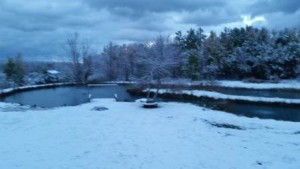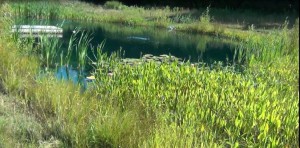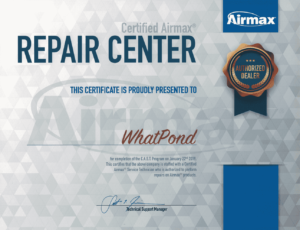With this past weekend here in northwest PA. the blanket of snow Sunday morning is a reminder to get things taken care of before winter really sets in and we can’t finish our projects until next spring.
I wanted to bring up a few different items to do around the pond to get it and any equipment ready for winter.
Pond equipment such as the pond fountain and or the aeration systems do need some attention before winter. Starting with the pond fountain which most of them now days are a floating type fountain should be pulled in for the winter months. This will keep them from freezing and possibly breaking them in the ice.
When the fountain is pulled either power wash or use a garden hose to wash on any buildup of growth. If the fountain has seals it is recommended to submerge the fountain in water while it sits for the winter. Just be sure the water doesn’t freeze. Sitting in water while out of the pond will keep the seal moist and help deter any cracking of the seals which will cause a failure of the fountain motor.
From the fountains we sell you should submerge the WP4 fountain and the Evolution from Aqua Control. The Aquamaster Fountains are built differently and shouldn’t require being submerged in water.
Aeration systems in winter: There are two options shut it off or let in run during the winter months. I always have had our aeration systems running during winter for two reasons, one is to keep a hole in the ice to allow toxic gasses to escape and the second was to keep the deck from heaving in the ice.
Keeping a hole in the ice to allow gasses to escape isn’t a 100% guarantee of not having a fish kill but will greatly increase the odds that you would not have a fish kill. These past few years have been brutal on the ponds, with ice coming on and not coming off until late spring there is no chance for these gasses to escape and we’ve seen plenty of fish kills.
The rule of thumb to figure out when to turn off the system in the fall and back on in the spring is when the water is at 50-55 degrees. When the temperature drops to that temp in the fall and warms up to that temp in the spring. As for fountains to go in or out of the pond the temp doesn’t matter that much since we are only affecting the surface water. We put our fountains in the spring once we know the ice is going to stay away.
If your aeration system only has one diffuser in the water, the best thing to do is move it to a shallow area of the pond or a place that is half the depth of the pond. So if your pond is 6’ deep, move the diffuser to a 3’ deep area.
Having more than one diffuser in the water the thought was always to turn off the deeper diffuser and let the one shallow one run for the winter months. We are going to change that thought a little bit now that we’ve seen and experienced what can or could happen by forcing all the air to one diffuser.
If the compressor is a linear diaphragm designed to run more than one diffuser we run a chance of over working the compressor diaphragms and cause premature failure. If your compressor is a piston type compressor would add more psi to the compressor and make it work harder, same thing with the linear compressor.
For the diffusers it may or may not be able to handle all the air from the compressor. With the cfm increased to one diffuser after turning off the others it could expand the rubber membrane even more than it normally operates adding stress to the membrane which again could cause premature failure.
For the linear compressor you’ll be listening to the sounds it makes when you turn of the other diffusers. For the piston type compressors you will look at the gauge to help determine the next steps.
After turning off the other diffusers you’ll see the remaining one you want to run for winter have a huge boil and the compressor sound like it is working harder.
Now take one of the tubing clamp and hose off one of the turned off diffusers and crack the valve until you see the boil come back down to the normal size it had been. You will also see the gauge drop or hear the sound of the compressor come back to normal.
Plants and weeds around the pond should be cut back so we don’t end up with that bio mass of plant material adding to the muck and nutrients in the pond. Cattails and bulrush could be left alone for erosion control but be sure to cut the seed head off the cattails, the brown fuzzy thing on top of the cattail. Then in spring you can cut and remove the cattails and bulrush. Sometimes we burn the bulrush but be careful with fire.
Lastly if you have been using our Beneficial Pond Bacteria’s they are good down to 35 degrees but we usually stop using them when the water hits 50 degrees. If you have any leftover bacteria, keep it from freezing as it will harm or kill the bacteria leaving useless. Maybe a few strains may survive but not to the fullest extent.
With winter approaching we also recommend that if you live in warmer climates than Erie, PA. to stock up now for your winter use or spring use of our bacteria since you will see water temperatures sooner than we will. The reason to stock up now is we really can’t ship until we are sure the bacteria or even pond dye won’t freeze in a warehouse or shipping truck during the hipping process. This goes for our manufacturer and other bacteria products on the website that won’t ship until we are sure the product will be safe. So if you are purchasing during winter and they say no problem? I would think twice.
One last item is if you are wanting to keep a hole in the ice and don’t want to go the full aeration system or don’t want to run your 1/3 horse or bigger compressor during winter please use the contact button at the top of the site and we will build a small economy system for up to 6’ deep and using only 35 watts of power, for around 475. These are special order at this time.



